
The fortifications of Copenhagen underwent a comprehensive modernization and expansion in the 17th century. The project was commenced and was largely the masterplan of Christian IV in the early 17th century but was continued and completed by his successors. The new fortifications relied on the existing, medieval fortifications of the city but the fortified area was extended and a defensive ring around the city completed particularly with new edifices facing the sea. The ring fortification consisted of four bastioned ramparts and an annexed citadel as well as various outworks.

Gothersgade is a major street in the City Centre of Copenhagen, Denmark. It extends from Kongens Nytorv to Sortedam Lake, passing Rosenborg Castle and Gardens, Nørreport Station and Copenhagen Botanic Gardens on the way.

St. Paul's Church is a Lutheran church in central Copenhagen, Denmark, also colloquially known as Nyboder's Church due to its location in the middle of the Nyboder area. It was designed by Johannes Emil Gnudtzmann and constructed from 1872 to 1877.

Nørre Voldgade is a street in central Copenhagen, Denmark. It runs north-east from Jarmers Plads for approximately 600 metres to Gothersgade where it turns into Øster Voldgade. The succession of Nørre Voldgade, Øster Voldgade and Vester Voldgade together forms a traffic artery which arches around the Zealand side of the central and oldest part of Copenhagen. Nørreport Station, Denmark's busiest railway station, is located in the street.

Kronprinsessegade is a street in central Copenhagen, Denmark. Noted for its fine Neoclassical houses, it extends from Gothersgade and runs along the southern boundary of Rosenborg Castle Garden, passing Sølvgade and the Nyboder district of old naval barracks before finally joining Øster Voldgade close to Østerport Station. The David Collection, a museum which displays a large collection of Islamic art as well as Danish and European fine and applied arts, is based at No. 30.

Borgergade is a street in central Copenhagen, Denmark. It runs from Gothersgade to Store Kongensgade. As one of relatively few streets in central Copenhagen, the street, in its western part, is dominated by modern buildings. The eastern part passes through the Nyboder district.

Gammel Mønt is a street in central Copenhagen, Denmark, located one block west of Gothersgade and Rosenborg Castle Garden.

Dronningens Tværgade is a street in central Copenhagen, Denmark, which runs from Bredgade to Rosenborg Castle Garden. The street originally formed a link between the King's Garden and the Queen's Garden. With the Odd Fellows Mansion on Bredgade and the central pavilions of the east fringe of the castle garden located at each their end, the street has axial qualities. These are accentuated by the Dronningegården Estate, a Functionalist housing complex from the 1940s, which forms an urban space around the intersection with Adelgade.
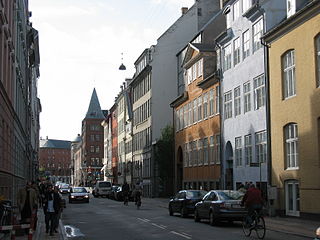
Toldbodgade is a street in central Copenhagen, Denmark. It extends north from Nyhavn at the Nyhavn Bridge, continuing Holberggade, passes Sankt Annæ Plads after just one block, and continues straight until it reaches West India Warehouse where it makes a sharp left turn which connects it to Amaliegade, its parallel street, at the rear of the Design Museum.

Sølvgade is a street in central Copenhagen, Denmark, extending north-west from Borgergade to The Lakes where Fredens Bro connects it to Fredensgade. The section from Kronprinsessegade to Øster Voldgade follows the walled north-eastern margin of Rosenborg Castle Garden and the next section, from Øster Voldgade to the intersection with Farimagsgade, named Sølvtorvet although it is little more than a busy street junction, separates Copenhagen Botanical Garden from Østre Anlæg.
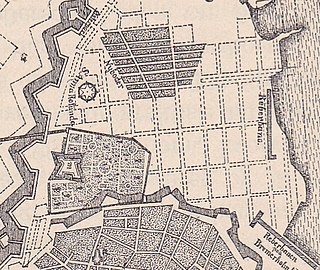
New Copenhagen or St. Ann's Town was a 17th-century expansion of fortified Copenhagen, Denmark.

Nansensgade is a street in central Copenhagen, Denmark, linking Gyldenløvesgade in the southwest with Gothersgade in the northeast. The street is known for its abundance of cafés and trendy shops, and plays host to an annual street festival. Charlotte Ammundsens Plads, located in front of the local community centre, is an urban space which connects Nansensgade to Nørre Søgade
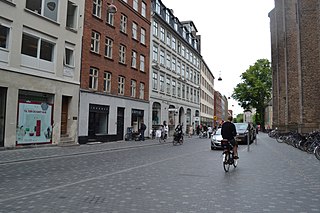
Landemærket, literally "The Landmark", is a street in the Old Town of Copenhagen, Denmark. It extends from Købmagergade along the north side of the Trinitatis Complex (Round Tower and Trinitatis Church, Guttenberghus and the Film House to Gothersgade at Rosenborg Castle Gardens.
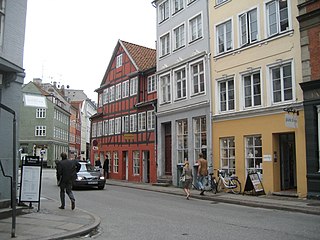
Grønnegade is a street in the Old Town of Copenhagen, Denmark, running northeast from Gammel Mønt to Gothersgade where it turns into Borgergade. It is part of Copenhagen's most exclusive shopping area, located northwest of Kongens Nytorv.
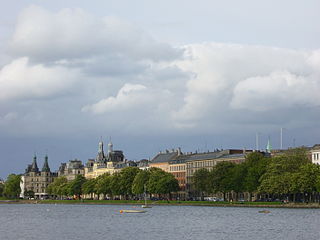
Vester, Nørre and Øster Søgade is a succession of streets along the eastern side of The Lakes in central Copenhagen, Denmark. The streets run from Gammel Kongevej to the south to the beginning of Østerbrogade at Lille Trianglen in the north. Vester Søgade runs from Gammel Kongevej to Gyldenløvesgade, Nørre Søgade runs from Gyldenløvesgade to Dronning Louises Bro, and Øster Søgade from Dronning Louises Bro to Lille Triangel.

Klerkegade is a street in central Copenhagen, Denmark. The street runs from Borgergade in the east to Rigensgade in the west, passing Adelgade and Kronprinsessegade on the way.
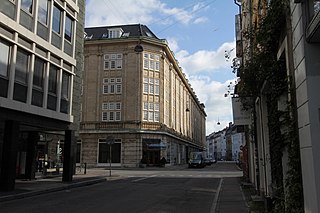
Møntergade is a street in the Old Town of Copenhagen, Denmark. It runs from Pilestræde in the west to Gothersgade in the east.

Rigensgade is a street in central Copenhagen, Denmark. It links Sølvgade in the west with Øster Voldgade in the east. An underpass for pedestrians link the beginning of the street with Rosenborg Castle Gardens on the other side of Sølvgade. Notable buildings include the former Garrison Hospital. and the Methodist Jerusalem's Church.

Åbenrå is a street in the Old Town of Copenhagen, Denmark. It runs from Landemærket in the southeast to Rosenborggade in the northwest, linking Vognmagergade with Tornebuskgade. The last part of the street passes the rear side of the grounds of the Reformed Church in Gothersgade. The former rectory associated with the church is located at No. 32-36. It is now houses the Danish Association of Architects.

Olfert Fischers Gade is a street in the Nyboder Quarter of central Copenhagen, Denmark and is named after the naval officer Olfert Fischer who commanded the Danish fleet in the Battle of Copenhagen in 1801. It runs from Store Kongensgade in the east to Rigensgade in the west, intersecting the streets Borgergade, Adelgade/Sankt Pauls Plads, Gammelvagt and Kronprinsessegade on the way. The street is closed to through traffic on the west side of Borgergade.
























